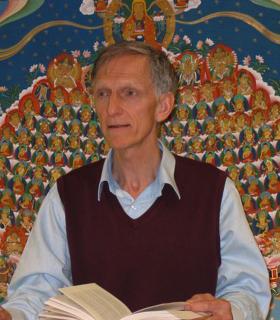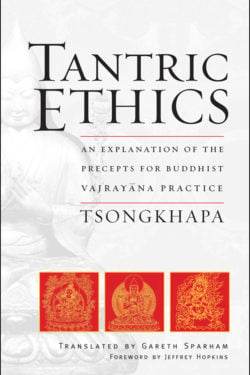Gareth Sparham

Gareth Sparham was a monk for more than twenty years and an oral interpreter for many learned lamas while living in India. He holds a PhD in Asian Studies from the University of British Columbia. The author and translator of numerous works, many focusing on the writings of Tsongkhapa, he has taught Tibetan language at the University of Michigan at Ann Arbor and the University of California at Berkeley. He lives with his wife in Walnut Creek, California.
Books, Courses & Podcasts
Vast as the Heavens, Deep as the Sea
Revered by many—especially His Holiness the Dalai Lama—as the very embodiment of altruism, the late Khunu Rinpoche Tenzin Gyaltsen devoted his life to the development of bodhicitta—the aspiration to achieve enlightenment for the sake of all sentient beings. Presented in both English and the original Tibetan, this modern classic is a collection of Khunu Rinpoche’s inspirational verse.

His Holiness the Dalai Lama reading from Khunu Rinpoche’s ‘Jewel Lamp’ during the second day of his teachings at the Sydney Entertainment Centre in Sydney, Australia on June 15, 2013. Photo/Rusty Stewart/DLIA 2013
Tantric Ethics
Tantra, or Vajrayana, Buddhism is a set of esoteric practices that involve mantra recitation and complex visualizations. Tantra constitutes the fabric of a Tibetan Buddhist’s daily practice, but no practice of tantra can be successful without adherence to the tantric precepts, the highest of three complementary sets of vows. Tsongkhapa is perhaps the greatest philosopher ever produced by Tibet’s Buddhist culture, and this book is a translation of his explanation of the tantric precepts.
Read Tsongkhapa’s biography at the Treasury of Lives.
The Perfection of Wisdom Tradition
The perfection of wisdom (prajñāpāramitā) is a key element of the path in Mahāyāna Buddhism. Wisdom here is the transcendent wisdom of a bodhisattva who has penetrated the nature of reality, the emptiness (śūnyatā) of all things. Sutras that take the Perfection of Wisdom as their name emerged in the centuries before and after the start of the Common Era and became foundational for the nascent Mahāyāna. These include the well-known Heart Sūtra and Diamond Cutter Sūtra as well as the Perfection of Wisdom sutras in eight thousand and a hundred thousand lines.
Study of the Perfection of Wisdom sutras in Tibet has historically been through commentaries on the Ornament for the Clear Realizations (Abhisamayālaṃkāra), a short verse distillation in eight chapters attributed to Maitreya that was expanded in India by such figures as Asaṅga, Haribhadra, and Ārya-Vimuktisena. The three works in the present volume reflect the diversity of the Tibetan commentarial tradition on these Indian works.
Ngok Loden Sherab’s (1057–1109) Topical Summary marks the beginning in Sangphu Monastery of the most influential Perfection of Wisdom commentarial tradition. Ngok’s short work leads the reader briskly through the Abhisamayālaṃkāra’s seventy topics, presenting what would become the standard framework for explaining the Perfection of Wisdom in Tibet. The entirety of Haribhadra’s Vivṛti commentary has been embedded in Ngok’s text.
Gyaltsab Darma Rinchen’s (1364–1432) Way to Practice the Sequence of Clear Realizations, structured as a defense of the meditation system set forth by his guru Tsongkhapa in the Great Treatise on the Stages of the Path to Enlightenment, links the stages of the path expanded into the seventy topics with the actual practices of an accomplished yogi. Working outward from the middle of the Abhisamayālaṃkāra’s fourth chapter, it explains how the Perfection of Wisdom is integrated into a total and complete meditational practice for the attainment of buddhahood.
The great Drukpa Kagyü scholar Kunkhyen Pema Karpo’s (1527–92) Sacred Words of Lord Maitreya is the most detailed and systematic of the three works, supplementing explanations of the Perfection of Wisdom based on the Abhisamayālaṃkāra with verses from the Mahāyānasūtrālaṃkāra (Ornament for the Mahāyāna Sūtras) and the Uttaratantra (Sublime Continuum). This work as presented here includes within it a complete translation of the Abhisamayālaṃkāra’s eight chapters.
Learn more about the Library of Tibetan Classics
Learn about becoming a benefactor of the Library of Tibetan Classics



